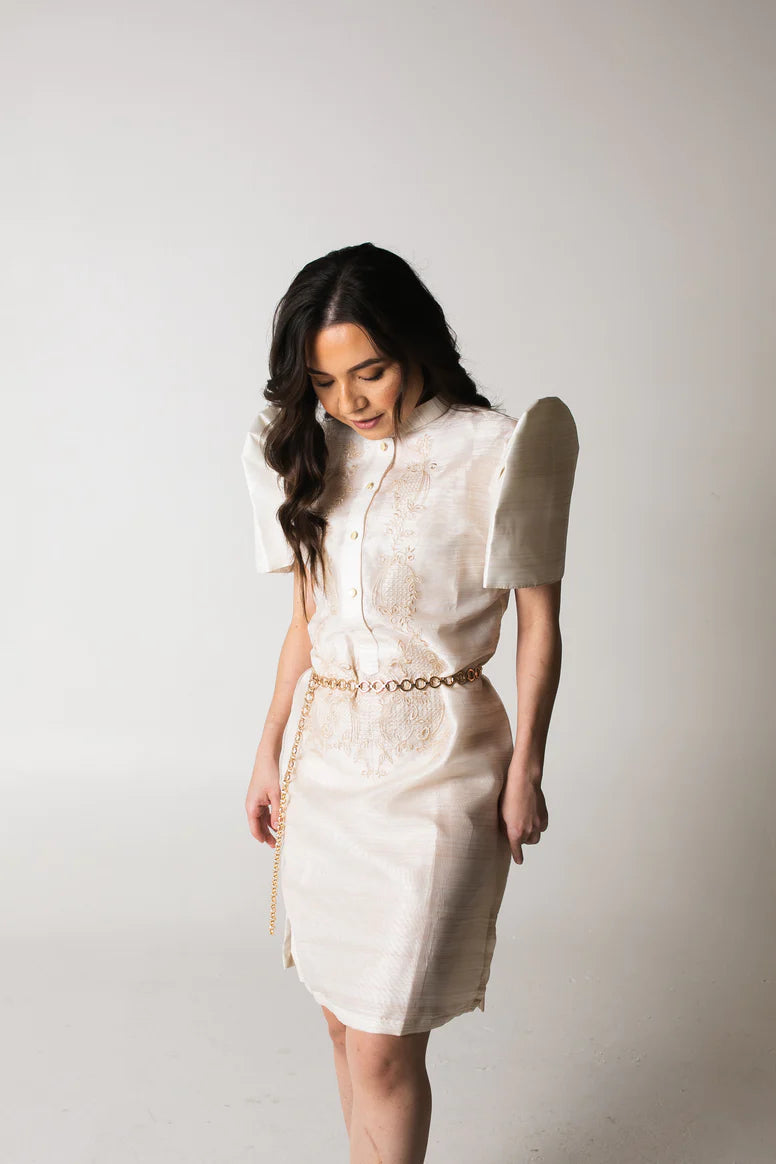The Filipiniana dress is one of the most iconic traditional garments of the Philippines. It is a representation of the country’s culture and heritage and a fashionable way to be proud of one’s roots. The Filipiniana dress is an elegant and timeless look that is both fashionable and sophisticated.
The style of the Filipiniana terno dress is such a significant national symbol that Filipinos and foreigners alike recognise it as something proudly of the Philippines. The most interesting features of this traditional Filipino clothing are briefly described below.
The Filipiniana Terno Dress
The terno dress has experienced every era in Philippine history. It has survived the early years of Spanish colonialism, the revolt against Spain, the American Revolution, the Philippine-American War, two World Wars, and more.
The Filipiniana dress is a two-piece ensemble (baro’t saya) consisting of a long graceful skirt and a fitted blouse. The ensemble is typically made of either piña, jusi, or cotton fabric. The piña fabric comes from the pineapple leaf, while the jusi fabric is made from abaca.
The skirt is usually ankle-length and often features intricate beadwork, embroidery, or lace. The blouse is usually made of piña fabric and is fastened with a sash around the waist.
The baro’t saya, a type of women’s traditional clothing worn in the Philippines that consists of the following:
- A blouse (also known as a camisa or baro)
- A folded rectangular piece of fabric placed over the shoulders (also known as pañuelo or fichu)
- A short rectangular piece of fabric (also known as a tapis) wrapped around a long skirt
- A skirt (also known as saya)
Analysing the Filipiniana terno dress from this time period and its four key parts can help you understand the development of the dress. This is how the individual pieces appear:
Camisa
This collarless blouse is constructed from thin, transparent materials like pia. The sleeves of the camisa were designed like bells or angel wings. In the middle to late 1800s, the correct term for the camisa’s sleeves was “pagoda,” which was “in” with Victorian-era Western shapes.
Pañuelo
This is a large triangular-folded piece of starched square cloth that is worn as a collar or ruffle over the shoulders. It is typically constructed from the same fabric as the camisa.
The pañuelo symbolised modesty because it was worn to protect the upper torso and nape from the low neckline and transparency of the camisa. With its additional embellishments and embroidery, it also served as an accent piece, and a pin or brooch held it in place.
Saya
This skirt hangs from the waist and reaches the floor, covering the bottom portion of the body. These were often made of single or double sheets, sometimes known as “panels” or “dos paños” (Spanish for two cloths).
Tapis
This knee-length overskirt fits closely around the hips. Tapis is typically made of opaque textiles like muslin and the madras cloth, and their designs might be basic or have a pattern that contrasts with the saya.
Conclusion
The Filipiniana dress is a beautiful embodiment of Filipino culture and history. With its intricate embroidery and colourful designs, the dress is a timeless piece that continues to captivate its audience.
It serves as a reminder of the value of upholding Filipino culture and customs as well as a symbol of the people’s tenacity and fortitude.
Exploring the fascinating pieces of the Filipiniana dress is an excellent way to learn more about the culture and history of the Philippines. The intricate designs and craftsmanship of each piece tell a story of tradition and heritage that is unique to the country.
Whether you’re looking for a traditional outfit to wear to a special occasion or a modern twist on an old classic, the Filipiniana dress is sure to make a statement.
If you’re looking for stylish, modern interpretations of the Filipiniana dress, Mestiza Filipina is here for you! We offer a curation of authentic Philippine dresses, barong Tagalog, boleros, and more.
These are designed to wear at events, weddings, work events, or everyday activities. Our garments are handmade by artisans in the Philippines and ready to ship worldwide. Check out our collections today!










